
Every Deity is a Principle existing from one Yug(Era) to another. The Principle of the Deity manifests in the saguṇ (Materialised) form as per the need of the times. Man begins to worship the Deity in its various forms.
Till the Satya Yuga, the spiritual level of all embodied souls was high and they acquired knowledge on the strength of their own spiritual practice. They possessed the state of ‘Soham’ (I am He). So Shri Dattatreya was required for the functions of dissolution and imparting knowledge to a very limited extent. Only the Vishnu principle in Him was active that time. As a symbol of this, the idol of Datta had only one head. Thereafter, during the Treta Yuga, the spiritual level of the embodied souls started to come down and they found it difficult to protect themselves and acquire knowledge on their own. To impart more knowledge to them through the subtle dimension, Shri Dattatreya had to bring out the dormant Brahma and Shiv principle in Him. To symbolise this, the three-headed idol of Dattatreya became prevalent.
From the year 1000 A.D. the idol of Shri Datta became three-headed. Given below is the list of all the objects in the hands of the three-headed Datta and their significance.
| Objects in the hand | What is it a symbol of ? |
| 1. Kamandaluand japamulu | Brahmadev |
| 2. Conch and chakra | Shrivishnu |
| 3. Trishuland damaru Deity | Shankar |
Note 1 : The Kamandalu (water pot) is the symbol of sacrifice – Kamandalu and stick are carried by Sanyasi (Ascetics). As an Sanyasi (Ascetic) is detached from worldly life, the kamandalu is a symbol of sacrifice.
Note 2 : The trishul (trident) in the hands of Shri Datta and Shiva – The trishul in the hands of Shri Datta and the one in the hands of Shiva have one significant difference between them. The Shrunga and a piece of cloth which is seen on the trishul of Shiva, is not present on the trishul of Shri Datta.The reason for this is that, none of the hands of Shri Datta is empty to play the Shrunga. The piece of cloth on the trishul of Shiva signifies a flag.
The cloth bag signifies elimination of ego
The cloth bag on Shri Datta’s shoulder symbolises a honey bee. Just like a honey bee collects honey from different flowers, Shri Datta wanders from door to door to ask for alms and collects them in the cloth bag. Wandering from door to door asking for alms eliminates the ego. Thus, the cloth bag on Shri Datta’s shoulder symbolises ‘elimination of ego’.
The Japamala (rosary) in Shri Datta’s hand represents perennial spiritual practice
Brahma of the three-headed Datta has a Japamala (rosary) in His hand. Datta’s chanting goes on continuously, without a break. Perennial spiritual practice is the quality of Shiv too. This feature of ‘perennial spiritual practice’ of both the Deities is found in Shri Datta. Perennial spiritual practice in the present Era means functioning either in a saviour or a destroyer form, as is required.’ – Ms. Madhura Bhosale
Implied meaning of Shri Datta’s family
1. Implied meaning of the cow (standing behind Shri Datta) : The earth and Kamadhenu (The wish-fulfilling cow)
2. The four dogs : The four Vedas
3. The Audumbar (Holy fig) tree : The venerable form of Shri Datta; because it contains a greater proportion of the Shri Datta Principle.
Reference : Sanatan Sanstha’s holy text, ‘Datta’

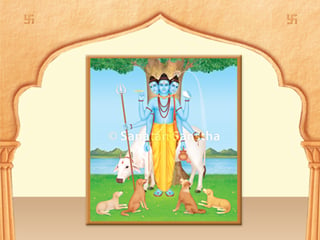
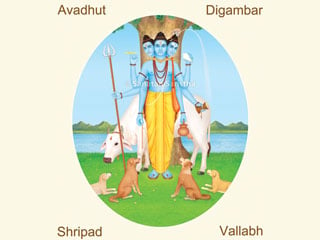 Names of Shri Datta and their meanings
Names of Shri Datta and their meanings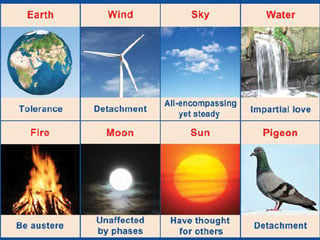 24 Gurus of Dattatreya - Gurus and subordinate Gurus
24 Gurus of Dattatreya - Gurus and subordinate Gurus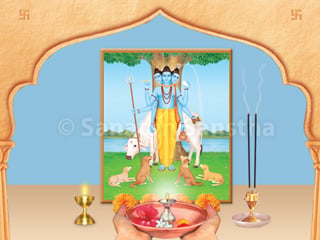 Worship of Shri Datta and Dattatreya puja
Worship of Shri Datta and Dattatreya puja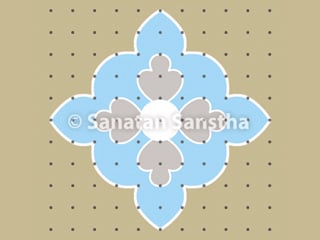 Rangoli designs associated with Shri Datta Principle
Rangoli designs associated with Shri Datta Principle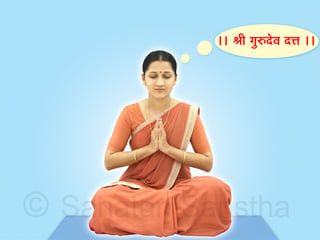 What is the significance of chanting Shri Gurudev Datta?
What is the significance of chanting Shri Gurudev Datta?